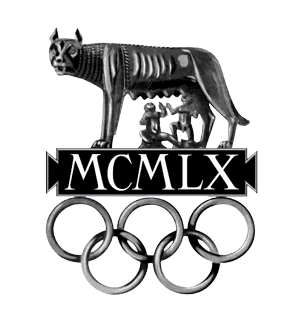
U.S. Marine Captain Victor in Rapid Fire Pistol; American Team Overall Showing Good
Russia maintained overall superiority with the United States finishing second on a fine general showing on the three firing ranges.
The Russians captured two gold medals, two silvers and three bronzes in the six events - two pistols, three rifles and the trapshooting.
The USA won a gold medal - its first since 1952 - in the Rapid Fire Pistol with Marine Captain William McMillan; a silver medal in the Small Bore Rifle; Prone, with Jim Hill, and a fourth in the Clay Pigeon firing with Jim Clark.
It was a great improvement over 1956 especially since a record field of 60 nations participated. Eight of the 10 Americans were active members of the Armed Forces.
Three Olympic records were set - two automatically because of the use of more difficult targets in the Small Bore Rifle events - and one tied. The scores were outstanding considering the adverse conditions the marksmen encountered on the Umberto I range (for the Small Bore Rifles and Pistols), the 300-meter Free Rifle range at Cesano, 16 miles from Rome, and the Clay Pigeon range at Lazio. Both Umberto and Lazio were only a mile from the Olympic village.
Weather conditions during the three weeks of practice were generally ideal with occasional light winds coming up in the afternoon periods. During the week of match firing, the conditions, however, included turbulent dust storms, rain, high winds and varying light.
In addition to McMillan, the other victors were Russia's Alexey Gustchin in the Free Pistol with an Olympic record of 560 points; Austria's Hubert Hammer in the 300-meter Free Rifle, 1,129; Russia's Viktor Shamburkim in the Small Bore Rifle, Three Positions, 1,149; Germany's 19-year-old Peter Kohnke in the Small Bore Rifle, Prone, 590 (one more than Hill), and Romania's Ion Dumitrescu in the Clay Pigeon, 192.
Six New champions were crowned and ten nations shared in the division of the 18 medals. Besides Russian and the USA, Germany was the only multiple medal winner, gaining a first and a third in rifle shooting.
The only genuine record to fall Torsten Ullman's 24-year-old mark in the Free Pistol of 559. That was the only record to escape the shootes in 1956. Russia's Gustchin broke it with a score of 560 with the .22 calibre pistol at 50 meters. Ullman, competing in his fifth Olympics, took fourth with 552. Army Sgt. Nelson Lincoln, 46, of Flagstaff, Ariz., was ninth with 543 and John Hurst, 36, a Los Angeles policeman, 17th with 538.
McMillan, a 31-year-old 6-footer from Turtle Creek, Pa., took the three-way shoot-off in the Raid Fire Pistol silhouette, firing a 25 meters after tying with Finland's Pentti Linnosvuo and Russia's Alexandr Zabelin. Each had tied the Olympic record of 587 set in 1956 by Romania's Stefan Petrescu.
McMillan scored 48-50-49 for a 147 total in topping Linnosvuo, a 1956 Champion, who had 139, and Zabelin with 135.
Army Sgt. Lawrence Mosely, 27, of Ft. Benning, Ga., was 16th with 577.
Hill, a 30-year-old Marine Sgt. from Oceanside, Calif., finished only one point behind Kohnke in the prone firing with the Small Bore Rifle at 50 meters. The marine lost out with a 94 score on his fourth series of 10 shots. His other scores were 100, 97, 100, 98, 100.
"I guess it was the wind - it was very strong there at the far left side of the range," he said of the 94. He had 589 to the German's 590.
Lt. Daniel Puckel, 27, Ft. Benning, the Pan American Games champion, was seventh with 585. He also was seventh in the three-position Small Bore with 585 points and 10th in the three-position Free Rifle with 1, 114. Hill was 24th with 1,115 in the three-position Small Bore. Army Lt. John Foster, 23, of Springfield, Ohio, was seventh in the Free Rifle with 1,121 points.
Second Lt. Jim Clark, 24, of Bartlesville, Okla., hit 188 of 200 birds in finishing fourth in the Clay Pigeon event, the USA's first entry in this competition since 1924. Arnold Riegger, 40, of Castle Rock, Wash., was 30th with 168. Italy's Galliano Rossini, the 1956 champion with 195, could only do 191 for second place - one point behind Victor Dumitrescu.
The USA team was picked on the basis of preliminary tryouts at 14 localities and then the final tryouts at Ft. Benning, Ga., July 18 - Aug. 5. The final field for the 10 berths included 21 civilians and 68 members of the Armed Forces. The team's 10th man was Corp. Gary Anderson of Axtell, Nebr., for the Free Rifle. He did not compete, however.
Col. Emmet O. Swanson, USMCR, a former Olympian from Minneapolis, Minn., was the team captain. Lt. Col. Sidney C. Carpenter of Fort Monroe, Va., was the coach.
1960 U.S. Olympic Book
1960 Olympic Shooting Events
By Robert W. Lowe, NRA Staff
The shooting events at the 17th Olympic Games in Rome, Italy, were fired Sept. 5 - 10, 1960, on 3 different ranges.
The small bore rifle, free-pistol, and rapid-fire pistol events were conducted at the Poligono Umberto I. This range is situated at the north edge of the city. For many years it was a 300-meter rifle range, but housing construction in the safety area forced the elimination of 300-meter rifle shooting.
For the Olympic Games the range was remodeled to handle all of the small caliber events. Facilities were installed for 50 targets at 50-meters distance. A spacious masonry shooting house was erected, the forward edge of the roof serving as the first baffle on this safety-type range. Several additional baffles were constructed downrange, and the range enclosed on both sides by high masonry walls so that it is impossible for a shot to get out of the intended path.
Target equipment consists of high-speed motor-driven carriers which transport the targets from the firing point to the 50-meter distance in about 6 seconds. Movement of the target trolleys is controlled by the shooter himself with a series of push buttons.
Since these targets moved back and forth so rapidly, it was not necessary for a shooter to have a spotting scope on the firing line with him and many preferred not to use them. Instead they simply pushed the button, recalled the target, had a look at the shot hold or shot group, and sent it on back to the 50-meter distance.
Shooting in the standing position is done from the concrete floor of the shooting house. At each firing point a hinged platform, attached to a 4-ft. high wall extending the width of the entire range, is lowered into position when the shooter desires to fire in the kneeling position. For prone shooting a hinged section of a table, permanently installed to the rear of the firing line, is swung forward to permit the shooter to get as close to the firing line as possible. The table is roughly 2½ ft. wide and about 8ft. long and, in typical European fashion, positioned in a straight line directly behind the firing point so the shooter is force to get nearly in line with the rifle pointing at the target. Attached to the rear end of the table is a compartment for storing targets, both new and fired, and a small bench and table for the scorer.
Scores posted on line
A placard was placed above each firing point which showed a facsimile of the flag of the firer's homeland as well as abbreviation of the name of that nation. During the elimination and record shooting a score card was put on an upright to the rear of the prone shooting bench. The Italian soldiers serving as scorers were equipped with a set of rubber stamps with numerals and 1" high. As the targets were fired and the scores determined unofficially were used to post the scores on the score cards mainly for the spectators' benefit.
United States shooters considered the range facilities excellent.
The long period of practice which was available to the shooters prior to the firing of the record events enabled all of the range-operating personnel to become familiar with the shooters and this helped greatly to minimize any language barrier that existed. There were many people around the range at most times who could speak English and Italian as well as other European languages, so there was, for all intents and purposes, no language barrier.
The rapid-fire pistol range was located behind or downrange from the 50-meter rifle range. The 2 ranges were divided by a high wall as well as an earth safety berm.
The rapid-fire pistol range was also a safety range with overhead baffles constructed of timbers so that no shots could be fired accidentally out of the range area. Each firing point on the rapid-fire pistol range was equipped with an overhead cover of translucent fiber glass beneath which was a canvas cover which slid on wires and could be moved into position if the shooter felt there was too much light falling on him.
Rapid-fire target equipment
The target-turning equipment on the rapid-fire pistol range is worked by electromagnets. It seemed to work faultlessly and the targets moved from the withdrawn position to the exposed position in a very minimum length time. There are probably the fastest turning types of targets we have ever seen.
The area on this range between the clubhouse and the 50-meter shooting house was landscaped much like a public park. There was a central crushed stone walk which was flanked on each side by flag poles from which flew the flags of the nation's competing in the Olympic Games. At the head of this walk was a large open area where 3 flag poles were situated; these were used during the awards ceremonies to fly the flags of the respective medal winners' homelands. The facilities at this range were more than adequate, ranging from a snack bar to rest rooms and offices, as well as a storage room in which competitors could keep their equipment and not have to transport it to and from the Olympic Village.
The trapshooting range, located in a different direction from the Olympic Village, is situated on a plateau overlooking the Tiber River valley. This range is within a residential district and enclosed on 2 sides by apartment houses. It belongs to the Tiro A Volo S. S. Lazio, one of the older trapshooting clubs in Italy, and is equipped with a standard 15-trap layout for International trapshooting. The range is situated on such high ground that the clay pigeons are always seen against a sky background. The shooting is done in a northerly direction so light conditions were favorable. The exposed nature of the range made the clay pigeons vulnerable to the wind, which at times had a pronounced effect.
At this range also there was a storeroom for the competitors' guns as well as snack bar facilities. Between the clubhouse and the range proper was a paved concrete terrace and seats were provided here so spectators could relax and watch the competition. As at most clay pigeon shooting ranges, there is no overhead cover for the firing points. Here however, because of the warm climate, beach-type umbrellas were located at each of the firing points.
300-meter rifle range
Free-rifle shooting at 300-meters distance was done on a newly constructed range situated on the reservation of the Italian Infantry School next to the town of Cesano. This reservation is approximately 20 miles northwest of Rome.
The range is located in a narrow draw which is just wide enough to accommodate 40 targets. The floor of the draw had been grated but the slope was such that the shooting house had to be a 2-story affair, with the shooting actually being done from the second floor. The shooting booths in the house were large enough to accommodate 2 shooters, and the front side of the shooting compartments were wide open from floor to ceiling and from partition to partition. The ground level of the shooting house was divided into jury rooms and storage rooms. Firing is done in a northeasterly direction.
The isolated nature of the 300-meter rifle range discouraged spectators from coming out to watch this type of shooting. During the record events the spectators were largely other team members, team officials, and organizing committee officials.
Dust a problem
On the day of the 300-meter match the weather became progressively worse as the day went on. By mid-day the sky had become overcast and the wind had picked up to about 20 miles an hour from the 7 - 8 o'clock direction. Light rain fell intermittently. The floor of the draw, only recently graded, had no vegetation growing to hold the soil in place. As a result the wind blew talcum-powder-like dust around, at times completely obscuring the targets and making it necessary to give additional time to competitors.
A high concrete-block wall, extending full length of the left side of the range, provided a covered access for persons going to and from the target pit. This passage made it possible to bring the fired targets promptly to the shooting house for official scoring.
The targets were carried in a cylindrical container, locked in the pits and unlocked by a scoring official upon arrival at the scoring room. Scorers were Italian soldiers.
Range officials and referees were appointed by the International Shooting Union and represented the various nations competing.
American Rifleman, Vol. 108, No. 11, November 1960
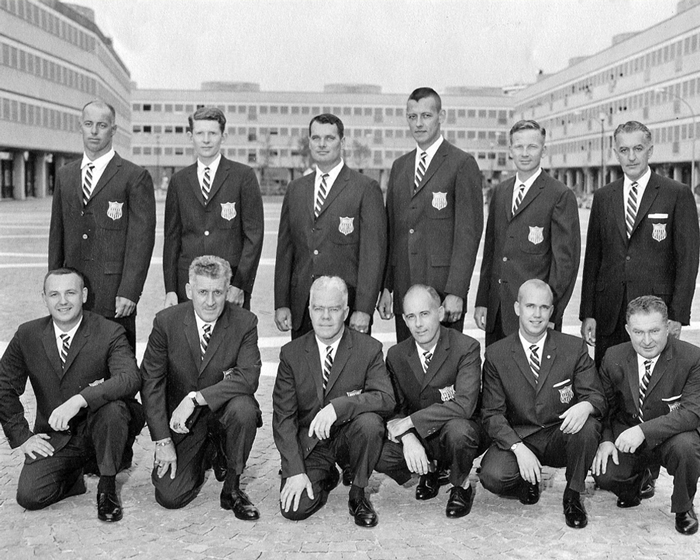
U.S. Shooting Team
Rifle Members
Gary L. Anderson, John R. Foster, James E. Hill and Daniel B. Puckel
Pistol Members
John W. Hurst, Nelson H. Lincoln, William W. McMillan, Jr. and Laurence K. Moseley
Trap Members
James R. Clark and Arnold O. Reigger
Team Management & Support
Emmet O. Swanson (Team Captain) and Sidney C. Carpenter (Team Coach)
Firing at the Poligono Umberto I Range
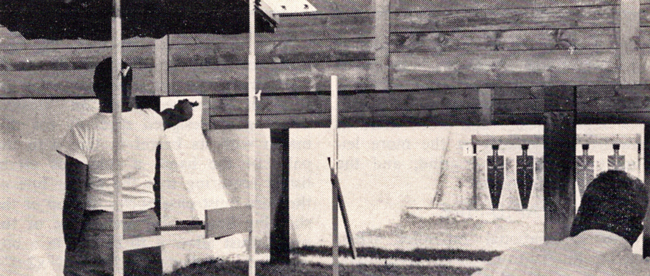
American Rifleman, Vol. 111, No. 7, July 1963
Olympic Team Departs
Five shooting members and the team captain of the U.S. Olymic Shooting Team departed the post on the first leg of their trip to Rome, Italy, and the 1960 Olympic Games.
Five other members of the team joined the party last weekend and the entire group flew from New York City to Rome Monday.
The team is slated to compete in the International competition Sept. 5 and 6.
Departing the post were 1st Lt. John Foster, Cpl. Gary Anderson, Sfc Lawrence Mosely, 2nd Lt. James Clark, Sgt. James Hill and Marine Corps Reserve Col. Emmet O. Swanson, team captain. All five shooters are Army personnel. [Correction: Sgt James Hill from the Marine Corps]
Other members of the team include two Army shooters, two civilians and a Marine Corps shooter. [Correction: two Marine Corps shooters]
They are 1st Lt. Daniel Puckel, civilian Arnold Reigger, Marine Corps Capt. William McMillan, Sfc Nelson Lincoln and Los Angeles policeman John Hurst.
The Bayonet, Friday, August 18, 1960
Service Competitors Hopeful As 1960 Olympics Commence
ROME, Italy - The big moment of a lifetime has arrived for 33 superbly-conditioned athletes from the Navy and Marine Corps who have won places on the 1960 U.S. Olympic Team. With the opening here of the XVII Olympiad, competition got underway for world recognition in the 19 sports events which make up the modern summer international games.
The Navy has 23 representatives connected with the various teams and the Marines have 10. Most of these are due to compete in the games as members of U.S. teams participating in world competition for supremacy in such sports as fencing, rowing, boxing, track events, pentathlon and Greco-Roman wrestling.
Others among the 33 Sea Service representatives are coaches, alternates, training squad members, or managers.
Swelling the Navy's number of representatives is the 8-oar rowing team, composed of midshipmen from the Navy Academy, which many regard as the world's finest rowing team.
A complete listing of the Navy and Marine members accompanying the U.S. team and the sports with which they are connected follows:
NAVY
- Lt. Charles E. Cobb Jr., track (alternate) 110 meter hurdles
- Lt. James A. Margolls, fencing, epee
- Ens. Alfonso H. Morales, fencing, sabre
- Ens. Joseph Paletta Jr., fencing, foils
- Ens. Roland R. Wommack, fencing, epee
- Andre R. Deladrier, fencing, coach
- Lt. Robert L. Beck, pentathlon
- Midn. Joseph A. Baldwin, rowing, 8-oar, no. 4
- Midn. Peter G. Box, rowing, 8-oar no. 5
- Midn. James B. Hitchborn, rowing, 8-oar, spare
- Midn. William G. Long, rowing, 8-oar, coxwain
- Midn. Michael McMahon, rowing, 8-oar, spare
- Midn. Mark W. Moore, rowing, 8-oar, bow
- Midn. Lyman S. A. Perry, rowing, 8-oar, stroke
- Midn. Warren E. Sweeter 3d, rowing, 8-oar, no. 2
- Midn. Gayle R. Thompson, rowing, 8-oar, no. 3
- Midn. Robert B. Wilson, rowing, 8-oar, no. 7
- Midn. Howard T. Winfree, rowing, 8-oar, no. 6
- Ens. Gordon C. Caswell, rowing, assistant manager and reserve coxwain
- Louis G. Lindsey, rowing, 8-oar, coach
- William C. Schenck, rowing, boatman-rigger
- Phil H. Kinyon, Greco-Roman wrestling (training squad) welterweight
- Hallow Wilson, Greco-Roman wrestling (training squad) heavyweight
MARINE CORPS
- 1st Lt. Alexander D. N. Breckenridge, track, marathon
- 1st Lt. Albert A. Cantello, track, javelln throw
- 2d Lt. Peter M. Close, track, 1500 meters
- Cpl. Percy J. Price Jr., boxing, heavyweight
- Charles L. Brown, boxing (alternate) bantamweight
- Ray E. Phillips, boxing (alternate) middleweight
- Sgt. James E. Hill, rifle, pistol and trap-shooting, small-bore rifle.
- Capt. William W. McMillan Jr., rifle, pistol and trap-shooting, rapid-fire pistol
- Sgt. Howard R. George, Greco-Roman, wrestling, light heavyweight
- Ronald E. Jackobson, Greco-Roman wrestling (training squad) middleweight
Navy Times, September 3, 1960
T.C. Marine Wins Olympic Medal
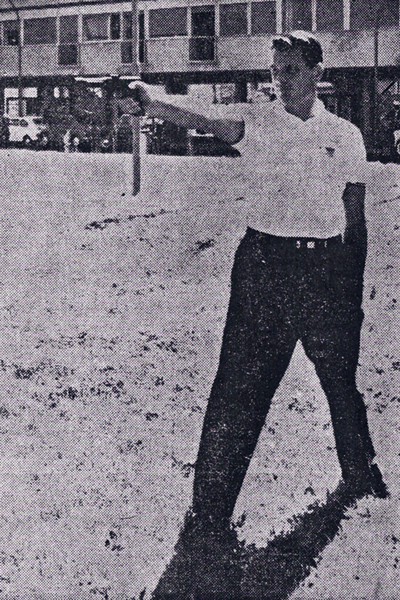
Marine Capt. William McMillan, 31, son of Mrs. W. W. McMillan of 1810 Main street, Turtle Creek, last week won an Olympic gold medal in Rome, beating out a Russian and a Finn to cop honors in the rapid-fire pistol competition.
The young Leatherneck, who enlisted upon graduation from Turtle Creek High, rose from buck private to the rank of captain.
In winning the coveted medal, Capt. McMillan racked up a total of 587 points in the two-day event, tying with Alexander Zabelin of Russia and Pentti Linnosvuo of Finland. Zabelin set the world record in Melbourne four years ago.
In the best-of-three playoff series, McMillan came through as his opponents wilter under the tension.
CABLEGRAM SENT
In recognition of his achievement, a cablegram was sent by President James M. Ecker of the Turtle Creek Chamber of Commerce, as follows:
"On behalf of the Turtle Creek Chamber of Commerce may I extend my heartiest congratulations on your glorious and thrilling victory in obtaining a Gold Medal for the United States of America in the 1960 Olympics.
"Your accomplishments and sportsmanship have done much to bring credit to your family and our community.
"We honored you once before, and I take pleasure in extending an invitation to you to attend a dinner in early November at which you will be one of the honored guests.
"I would appreciate hearing from you as to your plans for arrival back in Pennsylvania.
Sincerely,
James M. Ecker, President
Turtle Creek Chamber of Commerce"
Unknown newspaper, September 1960
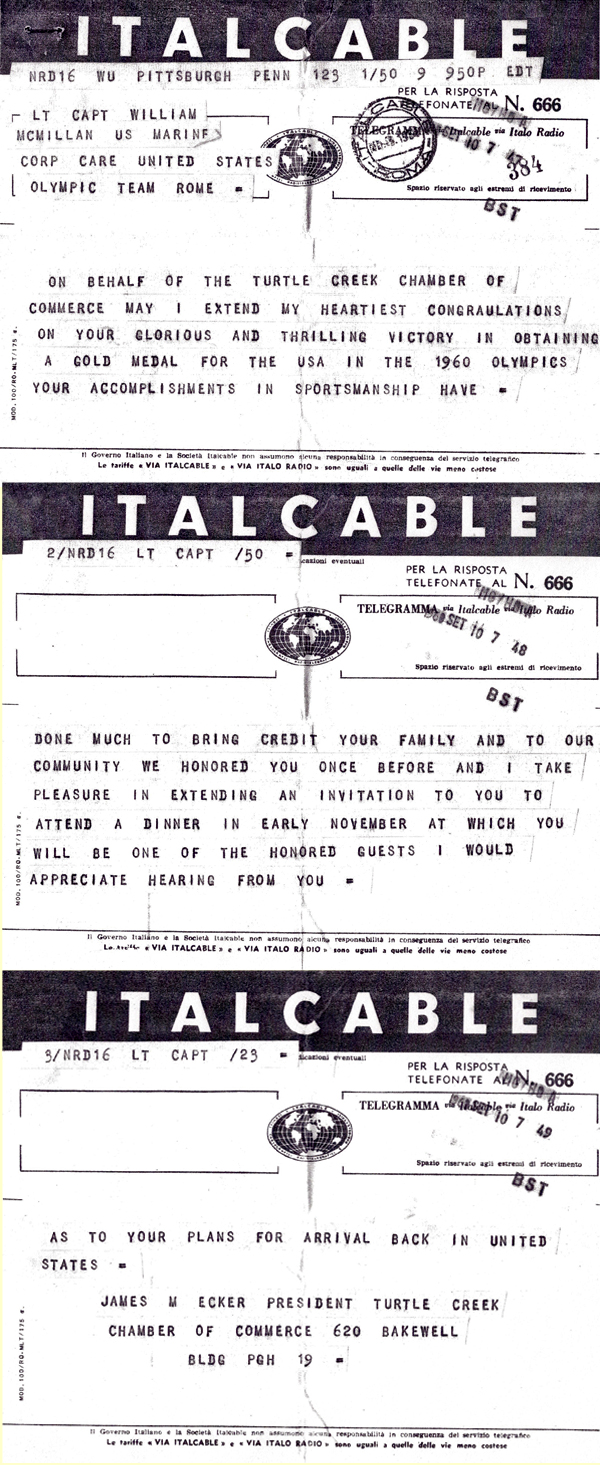
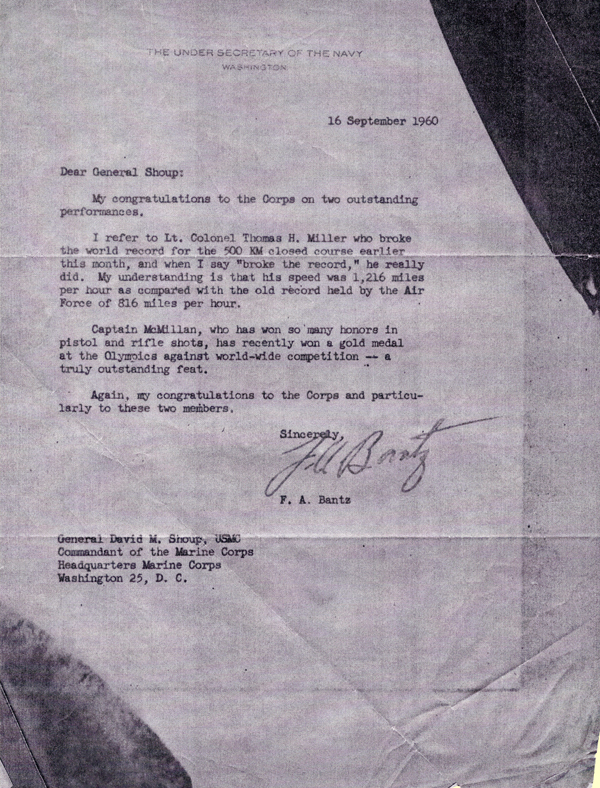
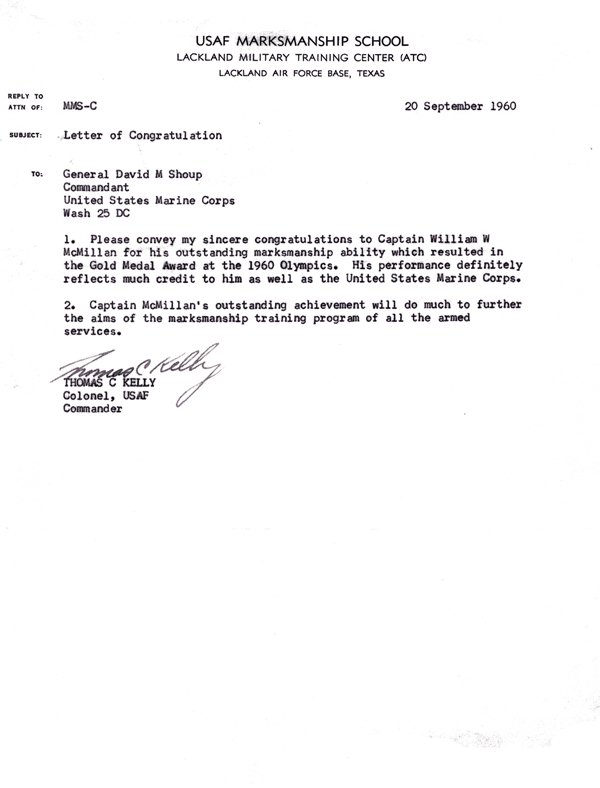
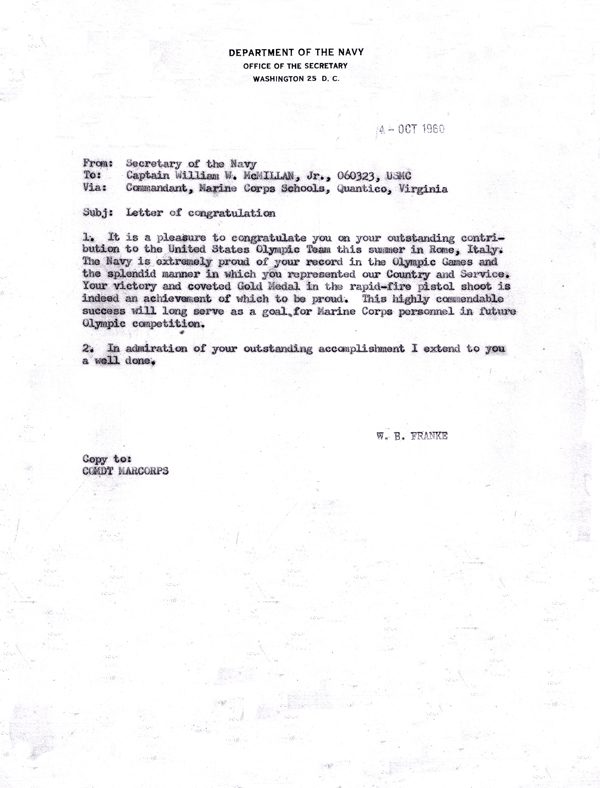
Franke Congratulates Marine Olympic Star
QUANTICO, Va. - Capt. William W. McMillan, Jr., gold medal winner in the rapid fire pistol event in the Rome Olympic Games has received congratulations from two distinguished sources.
Secretary of the Navy William B. Frankie and Col. Robin C. Montgomery, commanding officer of the Army's Advanced Marksmanship Unit in Washington, D.C., both expressed their congratulations to McMillan by letter.
The letter from SecNav read in part: "The Navy is extremely proud of your record in the Olympic Games and the splendid manner in which you represented our country and service. This highly commendable success will long serve as a goal for the Marine Corps personnel in future Olympic competition."
Montgomery's letter said: "Every member of the Army Marksmanship fraternity was watching the performance of the American shooting contingent and our pride in you accomplishment was as pronounced as though one of the Army men had won."
McMILLAN WON the 33rd gold medal for the U.S. in a shoot-off with a Russian and a Fin after each had complied a 587 score at the end of regular competition.
The Marine, known for his coolness under pressure, scored 147 out of a possible 150 in the shoot-off to beat the Finn and Russian, who could only muster 140 and 135 respectively.
McMillan is officer-in-charge of Range 1 at the Calvin A. Lloyd Rifle Range here at the Marine Corps Schools.
Quantico Sentry, September 1960
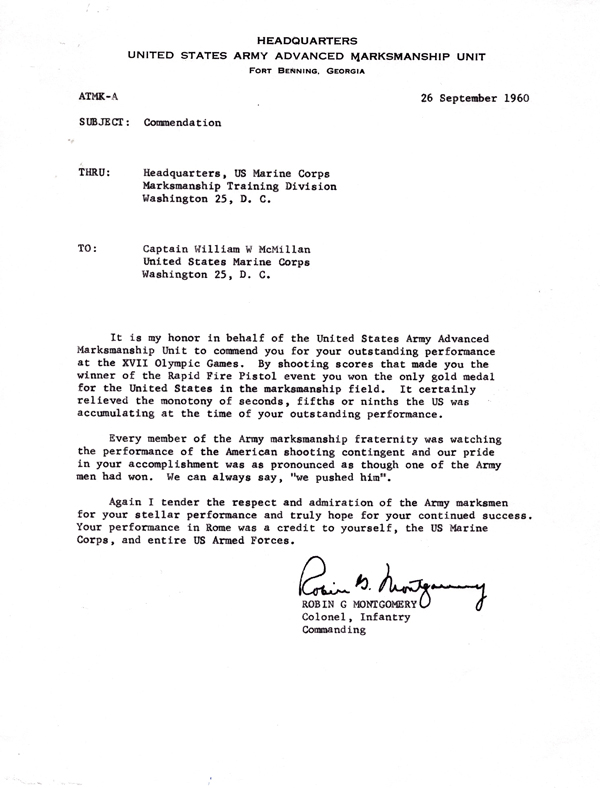
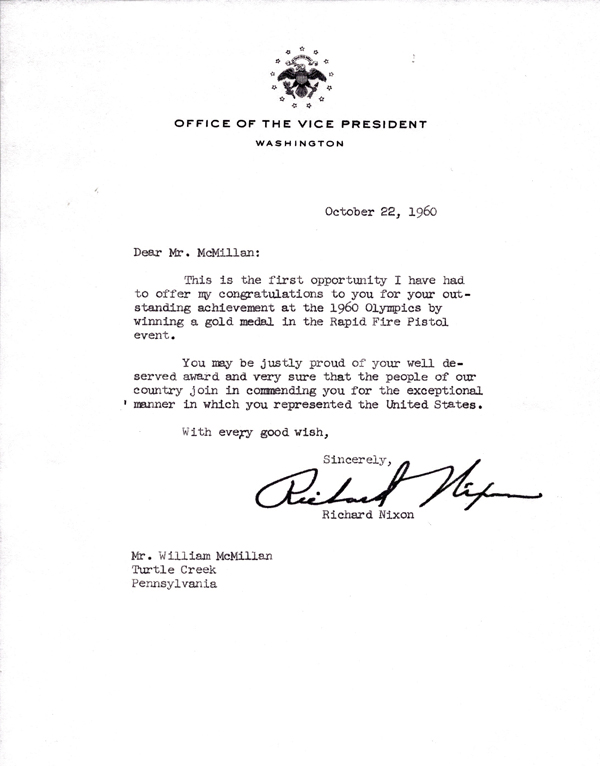
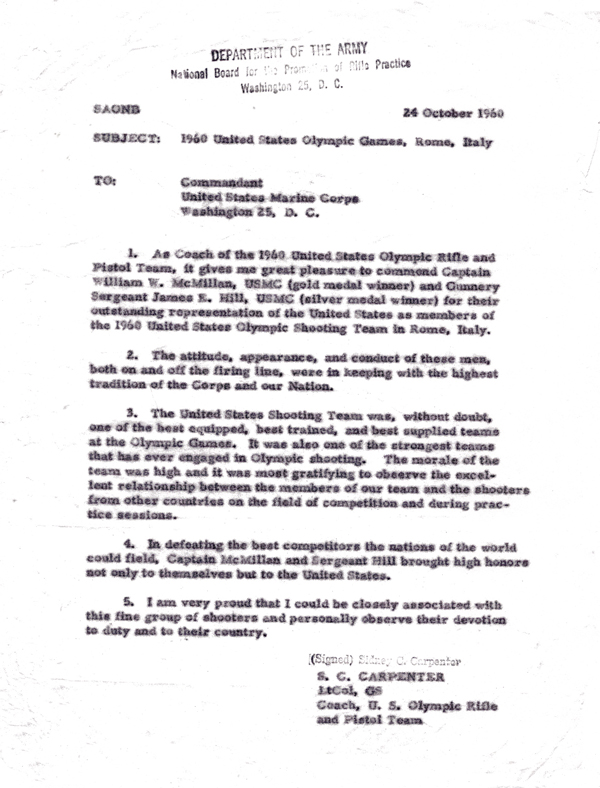
McMillan Heads For Nearest Phone
ROME, Sept. 9 — "The first thing I want to do is telephone home," said Capt. Bill McMillan, a former San Diego Marine, today after winning the Olympic Games rapid fire pistol shooting championship.
"My wife's been my greatest rooter," said the product of Turtle Creek, Pa. "I want to tell her about it."
McMillan outlasted Finnish and Russian sharpshooters in a tense shoot-off after the trio had tied at the end of the two-day regulation competition. McMillan, who won the world title in Moscow in 1958, dead-locked today with Finland's Pentti Linnosvvo and Russia's Alexander Zabelin with identical scores of 587.
McMillan scored 147 of a possible 150 in the three-round shoot-off, while the Finn had 139 and the Russian 135.
McMillan, now assigned at Quantico, Va., said he was angry with himself and disgusted when he came off the line with his 587. "I just gave myself a real talking to," he beamed. "I've been shooting much better than that, and I knew I could do it. McMillan uses standard equipment while the others use "tricked up" pistols and ammunition.
"The pistol," said McMillan, "is just as it comes out of the box, with no special grips. I even took the compensator off, so it feels more like a .45, which I shoot most of the time, and the ammunition is regular, standard ammunition.
Said McMillan of his triumph: "It means that's one for the good ole USA, and one less for Russia."
McMillan was at Marksmanship Training Unit at Camp Matthews in San Diego from Oct. 1956 to Nov. 1959. He transferred to Officers' ordnance school at Quantico, Va., his present assignment. He has been a Marine 14 years, up from the ranks, and has been shooting since he was 12.
He fired in the Helsinki Olympics in 1952 and in the Moscow Shooting Championships in 1958, winning the world's center-fire title in the Russian affair.
San Diego Union, Saturday, September 10, 1960
Mrs. McMillan Knew He'd Win
ROME, Sept. 10 (UPI) - Capt. William W. McMillan, of the Marine Corps had just won a gold medal with a rapid fire pistol and he was sitting in his quarters in the Olympic village yesterday afternoon opening his mail.
"Ah, a letter from my wife," the Turtle Creek, Pa., man smiled. "She writes that she has complete confidence in me, knows I'll win and please do not be nervous."
"If I had read this before I went out to the range this morning, I probably would have been tense."
"I can just picture that," grinned one of his fellow marksmen, Sgt. Larry Mosely of Fort Benning, Ga. "This guy specializes in making his friends nervous." He won the title this morning in a shoot-off, which means he did it in the last four seconds, and he did the same thing when he won the championship in Moscow."
McMillan had completed the regular competition with 587 points, equaling the Olympic record, but he was deadlocked with Pentti Linnosvuo of Finland and Alexander Zabelin of Russia. In the shoot-off, the Marine captain rolled up 147 points out of a possible 150, against the 139 for the Fin and 135 for the Russian.
In the rapid fire test, the marksmen shoot at five life-size silhouette targets from a distance of 25 meters. They fire five shots in four seconds, which explains his teammate's reference to "Four-second McMillan."
McMillan has been in the Marine Corps for 13 years, was in Korea for four months as a staff sergeant early in 1953, before he was shipped back to an officers candidate school.
He was on the 1952 Olympic team, was much better in practice than he was in competition and finished seventh. He failed to make the 1956 squad. What happened to him four years ago?
"You're allowed two alibis and I had three," he said. "I had gun trouble."
The captain grew up in Turtle Creek, Pa., and wasn't particularly inclined toward athletics.
"I liked football," he explained, "but Leon Hart and I were in the same class in high school. I weighed 140 and I wasn't tempted to tangle with him."
Hart was an All-American end at Notre Dame and subsequently tossed his 270 pounds around on behalf of the Detroit Lions.
McMillan went directly into the Marine Corps from high school, and at 31, he's a nerveless, 200 pounder. His victory was the first for the U.S. in rapid fire pistol shooting since it was added to the Olympic program in 1936.
The Pittsburgh Press, Pittsburgh, Pennsylvania, Sunday, September 11, 1960, Page 9
Capt. McMillan Wins Gold Medal At Olympic Games
Long careers in competitive military shooting paid off last week for the two Marine shooters competing in the 17th Olympic Games in Rome. GySgt. James E. Hill of MCRD and Capt. William W. McMillan, a former Depot Shooter now stationed at Quantico, both came through with outstanding performances in their specialties while competing for the U.S. team.
Gold Medal
Capt. McMillan, one of the nation's all-time great pistol shooters, accounted for the 33rd gold medal in the record American collection of 34 by winning the rapid fire pistol competition.
Capt. McMillan, already regarded as one of the world's top pistol performers after a history of winning performances in the United States, Russia and other foreign countries, captured the gold medal by scoring 147 out of a possible 150 in a dramatic shoot-off for first place.
Regulation Tie
The Marine medalist was deadlocked with Alexander Zabelin of Russia and Finland's Pentti Linnosvuo at 587 out of 600 at the end of the regulation match, forcing the extra round.
Russia's Zabelin took the early lead in the shoot-off with a 49 out of 50 to McMillan's 48 and Linnosvuo 46.
McMillan took the lead at the end of the second round, however, firing a perfect 50, while Zabelin faltered to a 37 and Linnosvuo scored a 45.
Each shooter fired a 49 the third time through, with McMillan's clutch second round giving him the medal with a final tally of 147, against 140 for the Finn and 135 for the Russian.
Hill lost by two points, 393 to 391 to 18-year-old phenom Peter Kohnke of Germany in the small bore competition.
Hill led for three rounds with scores of 100, 97 and 100 to Kohnke's 86, 100 and 99, but faltered to a 94 on the fourth round, while the German lad shot 98 to take the title.
Disastrous 4th
The 5-11, 165-pound Depot shooter lost his lead on a disastrous fourth shot during the final round, and couldn't catch up.
"I think the wind blowing across the ranged bothered him on that shot," stated the young German champion. "Until then, I thought he had me beat."
MCRD Chevron, Friday, September 16, 1960
Sons of Westinghouse Employees Win Honors at Olympic Games
ROME, ITALY - Sons of two Westinghouse employees came through with honors in the 1960 Olympics this month.
They were Captain William W. McMillan, Jr., who shot his way to a gold medal in pistol competition, and Steve Clark, a 16-year-old swimmer who helped crack the world record as anchorman on the 400-meter medley relay team.
Captain McMillan's father, W. W. McMillan, is a foreman in the Component Products Department, East Pittsburgh.
Steve's dad, Lyman Clark, is Sales Manager at Sunnyvale.
In the finals, Captain McMillan was deadlocked with Pentti Linnosvuo of Finland and Alexander Zabelin of Russia. But the Marine Captain settled the score in the shoot-off with 147 points out of 150.
Unknown newspaper, September 1960
McMillan Gains Honors For '60 Olympic Medal
MARINE CORPS SCHOOLS, QUANTICO, VA., Oct. 13 - Captain William W. McMillan, Jr., Marine Corps Schools' Gold Medal winner in the Rapid Fire Pistol event in the past Olympic Games in Rome, recently received congratulations from two distinguished sources.
Secretary of the Navy William B. Franke and Colonel Robin C. Montgomery, Commanding Officer of the Army's Advanced Marksmanship Unit stationed in Washington, D.C., both expressed their congratulations to the Marine Captain in letters received here this week.
The letter from the Secretary of the Navy read in part: "The Navy is extremely proud of your record in the Olympic Games and the splendid manner in which you represented our Country and Service. This highly commendable success will long serve as a goal for Marine Corps personnel in future Olympic competition."
Colonel Montgomery's letter stated: "Every member of the Army Marksmanship Fraternity was watching the performance of the American shooting contingent and our pride in your accomplishment was as pronounced as though one of the Army men had won. We can always say, 'We pushed him.'"
Captain McMillan won the 33rd Gold Medal for the United States in a shoot-off with a Russian and Finn after each had complied a 587 score at the end of regular competition.
The Marine, known or his coolness under pressure scored 147 out of a possible 150 in the suspenseful finale to easily win over the Finn and Russian who could only muster 140 and 135 respectively.
The Gold Medal winner is presently assigned as Officer in Charge of Range One at the Calvin A. Lloyd Rifle Range here at Marine Corps Schools.
MCRD Chevron, Friday, October 21, 1960
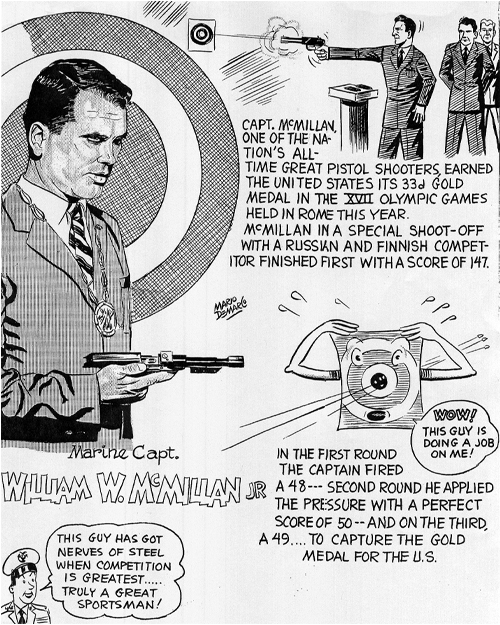
Drawing by Mario DeMarco, Sports Artist & Cartoonist
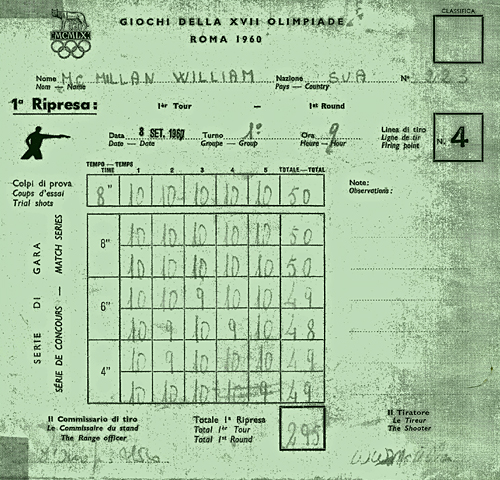
Score Card for September 8, 1960
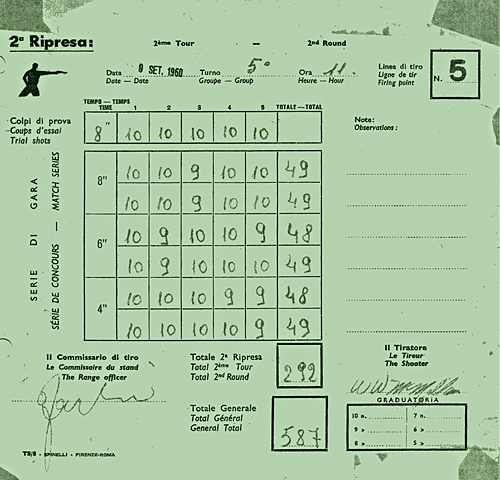
Score Card for September 9, 1960
| Place | Name | Country | 1st Stage | 2nd Stage | Total Points |
|---|---|---|---|---|---|
| 1st | William W. McMillan | USA | 295 | 292 | 587 |
| 2nd | Pentti Linnosvuo | Finland | 294 | 293 | 587 |
| 3rd | Alexander Zabelin | USSR | 291 | 296 | 587 |
| 4th | Hanoruedi Schneider | Switzerland | 292 | 294 | 586 |
| 5th | Stefan Petrescu | Romania | 291 | 294 | 585 |
| 6th | Cavril Maghiar | Romania | 292 | 291 | 583 |
| 7th | Czeslaw Zajac | Poland | 290 | 292 | 582 |
| 8th | Jiri Hrnecek | Czechoslovakia | 290 | 292 | 582 |
| 9th | Josef Svab | Czechoslovakia | 293 | 288 | 581 |
| 10th | Jan Wallen | Sweden | 292 | 288 | 580 |
| 11th | Stig Berntsson | Sweden | 291 | 289 | 580 |
| 12th | Evgeniy Cherkasov | USSR | 296 | 283 | 579 |
| 16th | Lawrence K. Mosely | USA | 286 | 291 | 577 |
Source: U.S. Olympic Committee Quadrennial Report
| Place | Name | Country | 1st Round | 2nd Round | 3rd Round | Total Points |
|---|---|---|---|---|---|---|
| 1st | William W. McMillan | USA | 48 | 50 | 49 | 147 |
| 2nd | Pentti Linnosvuo | Finland | 46 | 45 | 49 | 140 |
| 3rd | Alexander Zabelin | USSR | 49 | 37 | 49 | 135 |
Source: U.S. Olympic Committee Quadrennial Report
| Place | Name | Country | Round 1 | Round 2 | Round 3 | Round 4 | Round 5 | Round 6 | Total Points |
|---|---|---|---|---|---|---|---|---|---|
| 1st | Alexei Gustchin | USSR | 94 | 93 | 95 | 96 | 93 | 89 | 560 |
| 2nd | Makhmud Umarov | USSR | 94 | 92 | 91 | 90 | 90 | 95 | 552 |
| 3rd | Yoshihisa Yoshikawa | Japan | 90 | 91 | 94 | 93 | 91 | 93 | 552 |
| 9th | Nelson H. Lincoln | USA | 91 | 88 | 93 | 88 | 89 | 94 | 543 |
| 17th | John W. Hurst | USA | 96 | 87 | 88 | 91 | 92 | 84 | 538 |
Source: U.S. Olympic Committee Quadrennial Report













